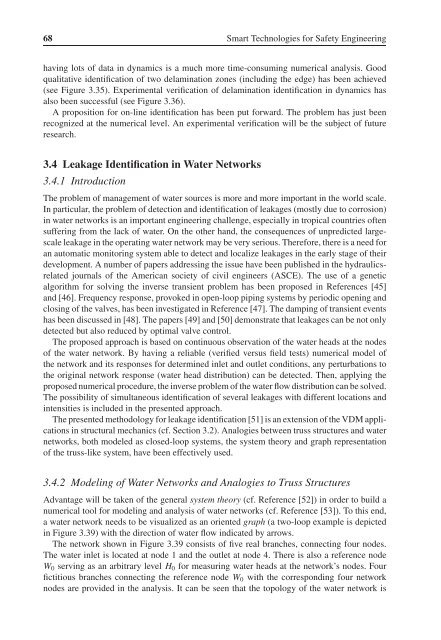smart technologies for safety engineering
smart technologies for safety engineering
smart technologies for safety engineering
You also want an ePaper? Increase the reach of your titles
YUMPU automatically turns print PDFs into web optimized ePapers that Google loves.
68 Smart Technologies <strong>for</strong> Safety Engineering<br />
having lots of data in dynamics is a much more time-consuming numerical analysis. Good<br />
qualitative identification of two delamination zones (including the edge) has been achieved<br />
(see Figure 3.35). Experimental verification of delamination identification in dynamics has<br />
also been successful (see Figure 3.36).<br />
A proposition <strong>for</strong> on-line identification has been put <strong>for</strong>ward. The problem has just been<br />
recognized at the numerical level. An experimental verification will be the subject of future<br />
research.<br />
3.4 Leakage Identification in Water Networks<br />
3.4.1 Introduction<br />
The problem of management of water sources is more and more important in the world scale.<br />
In particular, the problem of detection and identification of leakages (mostly due to corrosion)<br />
in water networks is an important <strong>engineering</strong> challenge, especially in tropical countries often<br />
suffering from the lack of water. On the other hand, the consequences of unpredicted largescale<br />
leakage in the operating water network may be very serious. There<strong>for</strong>e, there is a need <strong>for</strong><br />
an automatic monitoring system able to detect and localize leakages in the early stage of their<br />
development. A number of papers addressing the issue have been published in the hydraulicsrelated<br />
journals of the American society of civil engineers (ASCE). The use of a genetic<br />
algorithm <strong>for</strong> solving the inverse transient problem has been proposed in References [45]<br />
and [46]. Frequency response, provoked in open-loop piping systems by periodic opening and<br />
closing of the valves, has been investigated in Reference [47]. The damping of transient events<br />
has been discussed in [48]. The papers [49] and [50] demonstrate that leakages can be not only<br />
detected but also reduced by optimal valve control.<br />
The proposed approach is based on continuous observation of the water heads at the nodes<br />
of the water network. By having a reliable (verified versus field tests) numerical model of<br />
the network and its responses <strong>for</strong> determined inlet and outlet conditions, any perturbations to<br />
the original network response (water head distribution) can be detected. Then, applying the<br />
proposed numerical procedure, the inverse problem of the water flow distribution can be solved.<br />
The possibility of simultaneous identification of several leakages with different locations and<br />
intensities is included in the presented approach.<br />
The presented methodology <strong>for</strong> leakage identification [51] is an extension of the VDM applications<br />
in structural mechanics (cf. Section 3.2). Analogies between truss structures and water<br />
networks, both modeled as closed-loop systems, the system theory and graph representation<br />
of the truss-like system, have been effectively used.<br />
3.4.2 Modeling of Water Networks and Analogies to Truss Structures<br />
Advantage will be taken of the general system theory (cf. Reference [52]) in order to build a<br />
numerical tool <strong>for</strong> modeling and analysis of water networks (cf. Reference [53]). To this end,<br />
a water network needs to be visualized as an oriented graph (a two-loop example is depicted<br />
in Figure 3.39) with the direction of water flow indicated by arrows.<br />
The network shown in Figure 3.39 consists of five real branches, connecting four nodes.<br />
The water inlet is located at node 1 and the outlet at node 4. There is also a reference node<br />
W0 serving as an arbitrary level H0 <strong>for</strong> measuring water heads at the network’s nodes. Four<br />
fictitious branches connecting the reference node W0 with the corresponding four network<br />
nodes are provided in the analysis. It can be seen that the topology of the water network is
















